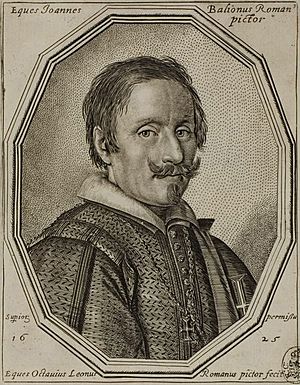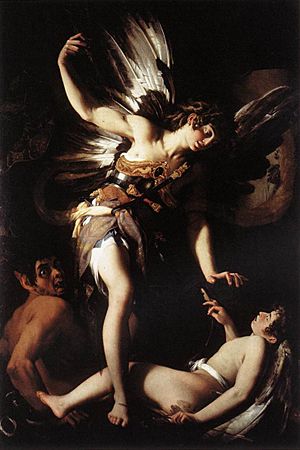Giovanni Baglione facts for kids
Quick facts for kids
Giovanni Baglione
|
|
|---|---|

Engraving by Ottavio Leoni, 1625
|
|
| Born | 1566 |
| Died | 30 December 1643 (age 77) Rome
|
| Nationality | Italian |
| Known for | Painter and biographer of artists |
| Movement | Late Mannerist, Baroque |
Giovanni Baglione (1566 – 1643) was an Italian painter and art historian. He is known for his beautiful paintings and for writing important books about other artists who lived in Rome during his time. He also had a famous disagreement with another artist named Caravaggio. Many of his artworks can still be seen in churches and art galleries in Rome and other places.
Contents
Life of a Roman Artist
Giovanni Baglione was born and died in Rome. He came from a noble family in Perugia. He learned to paint from an artist named Francesco Morelli. Baglione mostly worked in Rome.
At first, his painting style was called late-Mannerism. This style was influenced by artists like Giuseppe Cesari. Later, he was influenced by the famous artist Caravaggio. After that, his style changed again, becoming more like other early Baroque painters such as Guercino. He always used a style called disegno, which means focusing on drawing and design.
From 1621 to 1622, Baglione worked for Duke Ferdinando Gonzaga in Mantua. There, he saw many amazing Venetian paintings, which influenced his art. After that, he returned to Rome and continued to get many painting jobs from the Pope and important families.
Giovanni Baglione had a very successful career. In 1606, the Pope gave him a special award called a Papal knighthood. He was also a member of Rome's main art school, the Accademia di San Luca, from 1593 until he died. He was even the president of the Academy three times! People sometimes called him Il Sordo del Barozzo because he was deaf. He passed away in Rome when he was 77 years old.
Baglione's Writings
Giovanni Baglione wrote two important books. The first was The nine churches of Rome (published in 1639). This book was a guide to the nine most important churches for pilgrims in Rome. It was special because it looked at art from all different time periods. Today, it helps historians understand what these churches looked like before they were changed over time.
His second book, published in 1642, was called The Lives of Painters, Sculptors, Architects and Engravers, active from 1572–1642. This book is still a very important source of information about artists who worked in Rome during his lifetime.
His biographies tell the stories of over two hundred artists. Baglione knew many of these artists personally. He wrote about their lives, their social status, and their habits. He always mentioned if an artist was part of the Academy of St. Luke or if they had received special honors. He wanted to show that artists were important and respected people.
Rivalry with Caravaggio
One of Baglione's most famous paintings is Sacred Love and Profane Love. He painted this artwork as a direct response to Caravaggio's painting called Amor Vincit Omnia.
Baglione's painting shows an angel (Sacred Love) stopping a meeting between Cupid (Profane Love) and the Devil. In one version of the painting, the Devil looks like a funny drawing of Caravaggio. Both paintings were ordered by brothers from the Giustiniani family. This showed the serious rivalry between Baglione and Caravaggio. Caravaggio and his friends even said that Baglione copied his style.
In 1603, Baglione took Caravaggio to court. He said that Caravaggio and his friends had spread insulting poems about him around Rome. Baglione had just finished a big painting for a church, and he believed Caravaggio was jealous.
During the trial, Caravaggio said that Baglione was not a good painter and that his new painting was "clumsy." Caravaggio was found guilty and spent two weeks in prison. Even though another artist, Orazio Gentileschi, said Baglione was a "first-class painter," Caravaggio's harsh words have affected how people see Baglione's art ever since.
Years later, Baglione wrote the first biography of Caravaggio. Even though he praised Caravaggio's early works, his dislike for the younger artist's personality and later paintings was clear.
Paintings by Baglione
Giovanni Baglione mostly painted religious scenes for churches in Rome. He also painted some mythological subjects.
He received many important jobs from the Popes during his career. For example, his painting Saint Peter Raising Tabitha from the Dead (1607) for St. Peter's Basilica earned him his knighthood. He also painted frescoes in the Cappella Borghese at Santa Maria Maggiore.
For the church of Santa Maria dell'Orto, he painted many works, including a series of frescoes about the Life of the Virgin. Other paintings include a Last Supper in San Nicola in Carcere and a Saint Stephen in the Cathedral at Perugia. He also painted a series of Apollo and the Muses.
Gallery
-
The Ecstasy of St Francis, 1601, Art Institute of Chicago
-
Euterpe (from the series Apollo and the Muses, 1621-1623)
Images for kids
See also
 In Spanish: Giovanni Baglione para niños
In Spanish: Giovanni Baglione para niños
- Artists in biographies by Giovanni Baglione





